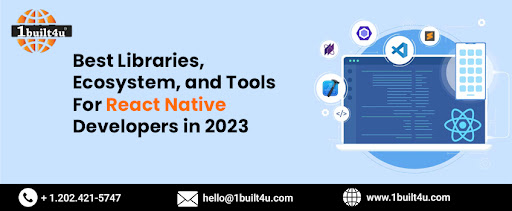
Best Libraries, Ecosystem, and Tools For React Native Developers in 2023
There are a plethora of tools and libraries available to developers for their React Native projects. However, the abundance of options also causes React Native developers to be unsure of which libraries and tools to use. Hence, our react native app development agency in Ashburn USA has noted a few to help your company pick better options.
Choose The Best Ecosystem
Build System
The build system enables developers to construct new web applications with the utmost care. It is critical to keep in mind that the build system is more than just a tool for running scripts; it also has the ability to change how applications look and work together. However, in order for this to occur, the following steps must be taken:
- Compilers and preprocessors are running.
- Production asset optimization
- Management of internal and external dependencies
Separate UI
Mobile app developers worldwide are aware that one of the greatest obstacles is the ability to write HTML, CSS, and JS in a single file. However, developers can effectively overcome this significant obstacle with the implementation of React Native.
Database
React Native provides numerous database-related options. Data can be stored locally or dynamically by database developers. Since the majority of applications require offline-to-online synchronization support, this is intriguing. Some of the databases that spread Native's local storage ecosystem are Firebase, PouchDB, WatermelonDB, SQLite, Realm Couchbase, and SQLite, which are also among the most widely used platforms.
Navigation
Navigation is preferred by many individuals and agencies offering react native development services. However, React Native navigation is actually quite challenging. Due to the abundance of options and solutions, React Native can be quite confusing. With the most recent version, V6, React Navigation is much more stable and simple to implement, which is a benefit. In addition, there are a variety of module-based implementations that give developers the ability to induce navigation through developed apps.
React Native Libraries
Due to their robustness, libraries are based on JavaScript, which guarantees improved performance. These modules stand out from the natively coded navigation tools precisely because of this advantage. In addition, when working on embedding navigation in React Native applications, developers have access to two distinct variants.
Flux, which is a powerful library liked by most developers. It is simple to use and aids in removing navigational logic from the developed apps' user interfaces.
Navigation with React is one of the most widely used navigation libraries and is compatible with both navigation tools and native apps. In addition, it is considered the enhanced version of the Navigational Experimental.
NativeBaseV3
NativeBase V3 is one of the most important application development libraries. It enables developers to create a native mobile application that runs on mobile frameworks. NativeBase V3 is one of the major frameworks. The application's interface, look, and feel are the primary objectives of these modules. Simply put, it aids in the programming of any application's user interface. Additionally, it is crucial to the development of a stunning app.
NativeBase V3 ensures improved performance by allowing you to provide object and array values to add responsive styles rather than manually adding responsiveness.
React Native Elements
React Native Elements makes it easier to combine multiple open-source UI modules in a single location. Numerous issues, such as tooltip, button, and tab, can be solved with React Native Elements. This library gives developers access to a number of pre-made mobile app development packages. The search bar, divider, and numerous other modules make up these packages.
React Native Lottie
This library makes it easier to add animations to applications. The JSON format is used for each and every animation that is added to any app using this library. The application is easier to manage because of the small size of the animations. The app's user interface also becomes simpler, more exciting, and easier to use as a result of this. Animations suitable for application development can be found in this free library.
React Native Maps
It facilitates the API's control of map features. The map's style can be customized in a number of ways with Mapview. In addition, you have the option of repositioning the map view. In addition to zooming into the location, developers can animate it to meet their needs.
Because it makes use of the React Native API known as Geolocation to determine the global position, developers find this module to be quite useful. Through navigator.geolocation, this Geolocation API is accessible on a global navigator object.
React Native Material UI
The React Native Material UI has approximately twenty components that are available for React Native. Avatars, dividers, subheaders, buttons, drawers, and toolbars are among these components. Material design is used in the construction of these components, which are highly customizable. Customization of the theme can be extended to other components from this location. Additionally, local modifications can be made by simply overriding styles wherever necessary. On GitHub, this library has received more than 3,000 stars.
React Native Developer Tools
If you are still unsure which React Native developer tools to use, do not worry! Our react native app development company has compiled a list of the best options. Some of these tools are helpful for new developers, while others are helpful for more seasoned ones.
Webstorm
Webstorm is a powerful, lightweight IDE for developing JavaScript, TypeScript, and web applications. It is also equipped to develop complex server-side and client-side applications using Node.js. Regardless of the project's level of complexity, this React Native tool aids in the rapid production of high-quality code.
In addition, it comes pre-installed with support for almost every well-known technology and a variety of built-in developer tools, so you can get right to work without having to spend time setting up the development environment.
Atom
Atom is a free, open-source text editor that is well-liked due to its hackability and simplicity. Atom was launched in February 2014 by GitHub. It is known that Linux, Mac, and Windows all work with Atom.
Atom also lets your react native app development agency choose from a variety of open-source packages to add more features and functionality. Custom designs and themes, cross-platform editing, a built-in package manager, and the ability to navigate multiple files from a single window are among its offerings.
Nuclide
Nuclide, like Atom, is a free open-source React Native application; However, the majority of the time, it is built on top of Atom as a single package. Additionally, Nuclide has a large developer community that is always willing to assist other developers and is highly hackable. Subsequently, Flow support is built into Nuclide. It has features like auto-complete, inline errors, and jump-to-definition.
Facebook released Nuclide in 2015. Hack development, working sets, remote and JavaScript development, in-built debugging, task runner, mercurial support, and other services are included.
Visual Studio Code
Microsoft's Visual Studio Code is well-known for its free and open-source React Native source code editor. For all JavaScript developers, this tool supports TypeScript, JavaScript, and Node.js. In addition, it has a robust ecosystem of extensions that are compatible with Python, Java, PHP, C#, and C++. Additionally, it works with runtimes like.NET and Unity.
The combination of developer tools like the IntelliSense code completion and debugging and source code editor makes this tool quite powerful. TypeScript and JavaScript are the programming languages used in this tool, which was released in April 2015. It also works with all of the important operating systems, including Windows, Mac, and Linux.
Android Studio
Android Studio is the best tool for developing apps for the Android platform. Developers will find it simpler to create React Native applications with Android Studio, thanks to this tool's use of various application development languages.
With the assistance of a vast catalog of emulated mobile phones that are available on the platform, Android Studio provides a number of options for debugging and testing applications, which is another significant advantage. In addition, Android Studio enables developers to learn about the various Android versions that will support their developed applications.
Conclusion
React Native's ecosystem is quite extensive. Despite the best efforts of our react native app development company in the USA, we did not include every developer tool, library, navigation, database, or other feature. It is such a vast ecosystem, it is possible that we may have missed some. For more information, or to avail our services, visit 1built4u.com .





